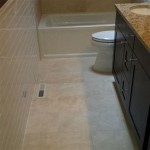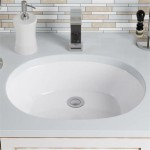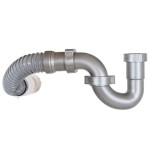How To Fix a Chip In Your Bathroom Sink
A chipped bathroom sink is more than just an aesthetic blemish. Left unattended, even a small chip can become a breeding ground for bacteria and mold, leading to unsanitary conditions. Furthermore, exposed edges are susceptible to further damage, potentially causing the chip to expand and compromise the structural integrity of the sink. Addressing a chip promptly not only restores the sink’s appearance but also prevents more significant and costly repairs down the line.
The feasibility of repairing a chip depends on the material of the sink. Porcelain, ceramic, acrylic, and cast iron sinks are all amenable to repair, albeit with slightly different techniques and materials. Understanding the sink’s composition is crucial for selecting the appropriate repair kit and ensuring a durable and aesthetically pleasing outcome. Attempting to repair a chip without considering the sink material is likely to result in a failed repair or further damage.
Before embarking on the repair process, gathering the necessary materials is essential. A porcelain or sink repair kit, readily available at most hardware stores, forms the core of the toolkit. The kit typically includes epoxy filler, hardener, sandpaper (various grits), a mixing stick, a small spatula or putty knife, and color-matching pigments. In addition to the kit, you will need household cleaning supplies, rubbing alcohol, painter's tape, and a soft cloth.
Safety should always be a primary concern. Working with epoxy and other chemical compounds necessitates adequate ventilation. Open windows and doors to ensure fresh air circulation throughout the bathroom. Wearing rubber gloves protects your hands from potential skin irritation caused by the repair materials. Eye protection, such as safety glasses, is advisable to prevent accidental splashes from entering the eyes.
Key Point 1: Preparation is Paramount
The success of any repair hinges on thorough preparation. The first step involves meticulously cleaning the damaged area and the surrounding surface. Use a mild household cleaner to remove any dirt, grime, soap scum, or other contaminants. Rinse thoroughly with water and allow the area to dry completely. Residue from cleaning agents can interfere with the adhesion of the repair filler, leading to a weak and short-lived repair.
Once the area is clean and dry, inspect the chip closely. Remove any loose or flaking pieces of the surrounding material. A small utility knife or a dental pick can be useful for this purpose. Be careful not to enlarge the chip while removing loose fragments. The goal is to create a stable and clean surface for the filler to adhere to.
Next, lightly sand the edges of the chip with a fine-grit sandpaper. This helps to create a slightly rough surface, promoting better adhesion of the filler. Avoid applying excessive pressure, as this can further damage the sink. The purpose of sanding is not to remove material but rather to create a textured surface for bonding.
Wipe away any sanding dust with a clean, damp cloth. Ensure that the area is completely free of dust and debris before proceeding to the next step. Even minuscule particles can compromise the integrity of the repair. Allow the area to air dry completely before applying the filler.
Finally, apply painter's tape around the perimeter of the chip, creating a clean and defined work area. The tape protects the surrounding surface from accidental smudges or spills of the repair filler. Position the tape carefully, ensuring that it creates a neat and precise boundary around the damaged area. This will result in a professional-looking repair.
Key Point 2: Mixing and Applying the Filler
Refer to the instructions provided with your sink repair kit for specific guidance on mixing the epoxy filler and hardener. The ratio of filler to hardener is critical for achieving the desired consistency and curing properties. Using too much or too little hardener can affect the strength and durability of the repair. Measure the components carefully, using the measuring tools provided in the kit.
Thoroughly mix the epoxy filler and hardener according to the manufacturer's instructions. Use the mixing stick provided in the kit to ensure that the two components are completely blended. Mix until the mixture is a uniform color and consistency. Inadequate mixing can lead to uneven curing and a weakened repair.
If your repair kit includes color-matching pigments, add them to the mixture in small increments, stirring thoroughly after each addition. Compare the color of the mixture to the color of the sink. The goal is to achieve a close match, ensuring that the repair blends seamlessly with the surrounding surface. Be patient and take your time to achieve an accurate color match.
Using the small spatula or putty knife, carefully apply the mixed epoxy filler to the chip. Work in thin layers, filling the chip gradually. Avoid applying too much filler at once, as this can lead to air bubbles and a weaker repair. Apply enough filler to slightly overfill the chip, allowing for sanding later.
Smooth the surface of the filler with the spatula or putty knife, ensuring that it is level with the surrounding surface. Remove any excess filler from the surrounding area. The goal is to create a smooth and even surface, minimizing the amount of sanding required later. Wipe the spatula or putty knife clean after each pass to prevent smearing.
Allow the filler to cure completely according to the manufacturer's instructions. The curing time can vary depending on the type of filler and the ambient temperature. Avoid touching or disturbing the filled area during the curing process. Prematurely handling the filler can disrupt the curing process and compromise the repair.
Key Point 3: Sanding and Polishing for a Flawless Finish
Once the filler has fully cured, carefully remove the painter's tape. Use a sharp utility knife to score the edge of the tape before peeling it away, preventing the filler from chipping or cracking. Remove the tape slowly and gently, avoiding any sudden movements that could damage the repair.
Begin sanding the filled area with a medium-grit sandpaper. Use light and even pressure, working in circular motions. The goal is to remove the excess filler and blend the repaired area with the surrounding surface. Avoid applying excessive pressure, as this can scratch or damage the sink. Inspect the surface frequently to ensure that you are not removing too much material.
Gradually transition to finer-grit sandpapers, working your way up to the finest grit provided in your repair kit. Each progressively finer grit will smooth the surface further, removing any scratches left by the previous grit. Continue sanding until the repaired area is completely smooth and flush with the surrounding surface.
After sanding, use a polishing compound to restore the shine to the repaired area. Apply a small amount of polishing compound to a soft cloth and rub it onto the surface in circular motions. Polish until the surface is smooth and glossy. The polishing compound will remove any remaining scratches and restore the original luster of the sink.
Finally, clean the repaired area with a mild soap and water. Rinse thoroughly and dry with a soft cloth. Inspect the repair closely to ensure that it is seamless and invisible. If necessary, repeat the sanding and polishing process to achieve a flawless finish.
Maintaining the repaired area is crucial for prolonging its lifespan. Avoid using abrasive cleaners or scouring pads on the repaired surface, as these can scratch or damage the filler. Instead, use a mild soap and water to clean the sink regularly. Promptly address any new chips or damage to prevent further deterioration. With proper care and maintenance, a repaired bathroom sink can provide years of reliable service.

How To Fix Chipped Porcelain Ceramic Sink Or Bath Tub With Milliput Putty

How To Patch A Porcelain Sink Himg Surface Repair

Sink Repair Happy Tubs Bathtub

Quick Fix For Chip In Porcelain Sink Airbnb Hosts Forum

How To Fix A Ed Porcelain Sink 8 Steps Prudent Reviews

How To Fix A In Porcelain Sink

Magic Porcelain 2 Part Chip Fix White Sink Tub Repair Easy Apply Com

Thrifty Mum Gets Rid Of A Giant In Her Bathroom Sink Using Easy Repair Kit And Saves Herself Hundreds The Sun

Home Dzine Diy How To Repair A Chipped Bath Or Basin

How To Fix A Ed Porcelain Sink 8 Steps Prudent Reviews







